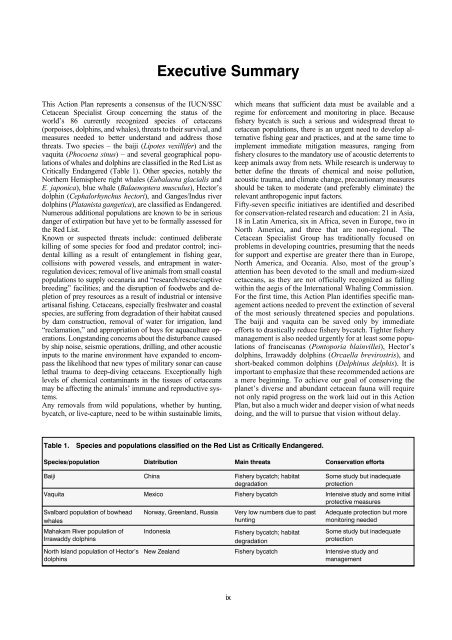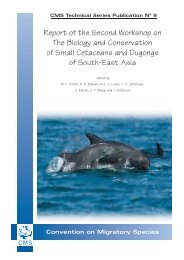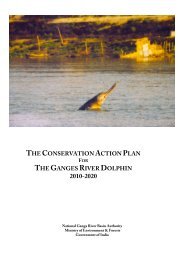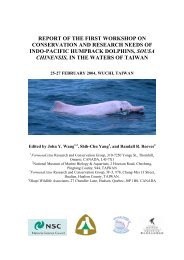Dolphins, Whales and Porpoises: 2002-2010 Conservation - IUCN
Dolphins, Whales and Porpoises: 2002-2010 Conservation - IUCN
Dolphins, Whales and Porpoises: 2002-2010 Conservation - IUCN
Create successful ePaper yourself
Turn your PDF publications into a flip-book with our unique Google optimized e-Paper software.
Executive Summary<br />
This Action Plan represents a consensus of the <strong>IUCN</strong>/SSC<br />
Cetacean Specialist Group concerning the status of the<br />
world’s 86 currently recognized species of cetaceans<br />
(porpoises, dolphins, <strong>and</strong> whales), threats to their survival, <strong>and</strong><br />
measures needed to better underst<strong>and</strong> <strong>and</strong> address those<br />
threats. Two species – the baiji (Lipotes vexillifer) <strong>and</strong> the<br />
vaquita (Phocoena sinus) – <strong>and</strong> several geographical populations<br />
of whales <strong>and</strong> dolphins are classified in the Red List as<br />
Critically Endangered (Table 1). Other species, notably the<br />
Northern Hemisphere right whales (Eubalaena glacialis <strong>and</strong><br />
E. japonica), blue whale (Balaenoptera musculus), Hector’s<br />
dolphin (Cephalorhynchus hectori), <strong>and</strong> Ganges/Indus river<br />
dolphins (Platanista gangetica), are classified as Endangered.<br />
Numerous additional populations are known to be in serious<br />
danger of extirpation but have yet to be formally assessed for<br />
the Red List.<br />
Known or suspected threats include: continued deliberate<br />
killing of some species for food <strong>and</strong> predator control; incidental<br />
killing as a result of entanglement in fishing gear,<br />
collisions with powered vessels, <strong>and</strong> entrapment in waterregulation<br />
devices; removal of live animals from small coastal<br />
populations to supply oceanaria <strong>and</strong> “research/rescue/captive<br />
breeding” facilities; <strong>and</strong> the disruption of foodwebs <strong>and</strong> depletion<br />
of prey resources as a result of industrial or intensive<br />
artisanal fishing. Cetaceans, especially freshwater <strong>and</strong> coastal<br />
species, are suffering from degradation of their habitat caused<br />
by dam construction, removal of water for irrigation, l<strong>and</strong><br />
“reclamation,” <strong>and</strong> appropriation of bays for aquaculture operations.<br />
Longst<strong>and</strong>ing concerns about the disturbance caused<br />
by ship noise, seismic operations, drilling, <strong>and</strong> other acoustic<br />
inputs to the marine environment have exp<strong>and</strong>ed to encompass<br />
the likelihood that new types of military sonar can cause<br />
lethal trauma to deep-diving cetaceans. Exceptionally high<br />
levels of chemical contaminants in the tissues of cetaceans<br />
may be affecting the animals’ immune <strong>and</strong> reproductive systems.<br />
Any removals from wild populations, whether by hunting,<br />
bycatch, or live-capture, need to be within sustainable limits,<br />
which means that sufficient data must be available <strong>and</strong> a<br />
regime for enforcement <strong>and</strong> monitoring in place. Because<br />
fishery bycatch is such a serious <strong>and</strong> widespread threat to<br />
cetacean populations, there is an urgent need to develop alternative<br />
fishing gear <strong>and</strong> practices, <strong>and</strong> at the same time to<br />
implement immediate mitigation measures, ranging from<br />
fishery closures to the m<strong>and</strong>atory use of acoustic deterrents to<br />
keep animals away from nets. While research is underway to<br />
better define the threats of chemical <strong>and</strong> noise pollution,<br />
acoustic trauma, <strong>and</strong> climate change, precautionary measures<br />
should be taken to moderate (<strong>and</strong> preferably eliminate) the<br />
relevant anthropogenic input factors.<br />
Fifty-seven specific initiatives are identified <strong>and</strong> described<br />
for conservation-related research <strong>and</strong> education: 21 in Asia,<br />
18 in Latin America, six in Africa, seven in Europe, two in<br />
North America, <strong>and</strong> three that are non-regional. The<br />
Cetacean Specialist Group has traditionally focused on<br />
problems in developing countries, presuming that the needs<br />
for support <strong>and</strong> expertise are greater there than in Europe,<br />
North America, <strong>and</strong> Oceania. Also, most of the group’s<br />
attention has been devoted to the small <strong>and</strong> medium-sized<br />
cetaceans, as they are not officially recognized as falling<br />
within the aegis of the International Whaling Commission.<br />
For the first time, this Action Plan identifies specific management<br />
actions needed to prevent the extinction of several<br />
of the most seriously threatened species <strong>and</strong> populations.<br />
The baiji <strong>and</strong> vaquita can be saved only by immediate<br />
efforts to drastically reduce fishery bycatch. Tighter fishery<br />
management is also needed urgently for at least some populations<br />
of franciscanas (Pontoporia blainvillei), Hector’s<br />
dolphins, Irrawaddy dolphins (Orcaella brevirostris), <strong>and</strong><br />
short-beaked common dolphins (Delphinus delphis). It is<br />
important to emphasize that these recommended actions are<br />
a mere beginning. To achieve our goal of conserving the<br />
planet’s diverse <strong>and</strong> abundant cetacean fauna will require<br />
not only rapid progress on the work laid out in this Action<br />
Plan, but also a much wider <strong>and</strong> deeper vision of what needs<br />
doing, <strong>and</strong> the will to pursue that vision without delay.<br />
Table 1.<br />
Species <strong>and</strong> populations classified on the Red List as Critically Endangered.<br />
Species/population Distribution Main threats <strong>Conservation</strong> efforts<br />
Baiji China Fishery bycatch; habitat<br />
degradation<br />
Some study but inadequate<br />
protection<br />
Vaquita Mexico Fishery bycatch Intensive study <strong>and</strong> some initial<br />
protective measures<br />
Svalbard population of bowhead<br />
whales<br />
Mahakam River population of<br />
Irrawaddy dolphins<br />
North Isl<strong>and</strong> population of Hector’s<br />
dolphins<br />
Norway, Greenl<strong>and</strong>, Russia<br />
Indonesia<br />
Very low numbers due to past<br />
hunting<br />
Fishery bycatch; habitat<br />
degradation<br />
Adequate protection but more<br />
monitoring needed<br />
Some study but inadequate<br />
protection<br />
New Zeal<strong>and</strong> Fishery bycatch Intensive study <strong>and</strong><br />
management<br />
ix





